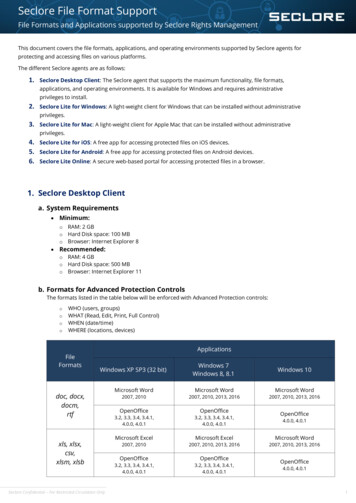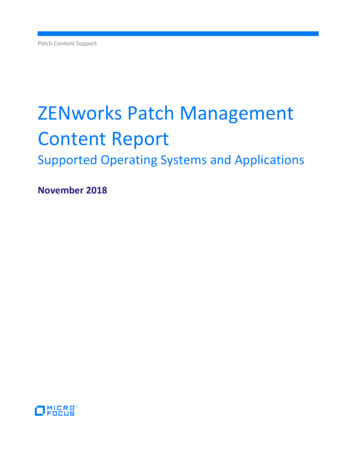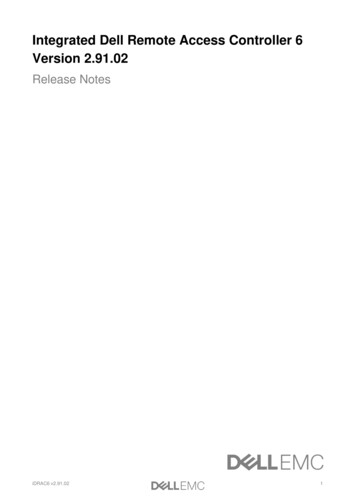
Transcription
Demystifying ModernWindows RootkitsBill DemirkapiIndependent Security ResearcherDemystifying Modern Windows Rootkits – Black Hat USA 20201
Who Am I? 18 years old Sophomore at the Rochester Institute of Technology Windows Internals Mostly self-taught (with guidance) Strong “Game Hacking” backgroundDemystifying Modern Windows Rootkits – Black Hat USA 20202
What Is This Talk About?In this talk, we’ll go over Loading a rootkit. Communicating with a rootkit. Abusing legitimate network communications. An example rootkit I wrote and the design choices behind it. Executing commands from kernel. Tricks to cover up the filesystem trace of your rootkit.Demystifying Modern Windows Rootkits – Black Hat USA 20203
Introduction toWindows RootkitsDemystifying Modern Windows Rootkits – Black Hat USA 20204
Windows Rootkits: An OverviewWhy would you want to use a rootkit? Kernel drivers have significant access to the machine. Same privilege level as a typical kernel anti-virus. Less mitigations and security solutions targeting kernel malware. Anti-Virus often have less visibility into operations performed bykernel drivers. Kernel drivers are often ignored by anti-virus.Demystifying Modern Windows Rootkits – Black Hat USA 20205
Example: Treatment by Anti-VirusAnti-virus tends to treat kernel drivers with significant trust comparedto user-mode applications.Excerpt from Malwarebytes’ Process/Thread Handle callbacksExcerpt from Carbon Black’s Process/Thread Handle callbacksDemystifying Modern Windows Rootkits – Black Hat USA 20206
Loading a RootkitDemystifying Modern Windows Rootkits – Black Hat USA 20207
Abuse Legitimate DriversThere are a lot of “vulnerable” drivers. With some reversingknowledge, finding a “0-day” in a driver can be trivial.Examples include Capcom’s Anti-Cheat driver Intel’s NAL Driver Microsoft themselves!Demystifying Modern Windows Rootkits – Black Hat USA 20208
Abuse Legitimate DriversUsing legitimate drivers has quite a few benefits too: You only need a few primitives to escalate privilege. Finding a “vulnerable” driver is relatively trivial (OEM Drivers ). Difficult to detect due to compatibility reasons.Demystifying Modern Windows Rootkits – Black Hat USA 20209
Abuse Legitimate DriversAbusing legitimate drivers comes with some strong drawbacks too Major issue of compatibility across operating system versionsdepending on the primitives you have. Much more likely to run into stability issues. The last thing you want is your malware to BSOD a victim.Demystifying Modern Windows Rootkits – Black Hat USA 202010
Just Buy a Certificate!For some red teamers, buying a legitimate code signing certificatemight be a good option. Useful for targeted attacks. No stability concerns.But Potentially reveals your identity. Can be blacklisted.Demystifying Modern Windows Rootkits – Black Hat USA 202011
Abuse Leaked CertificatesInstead of buying a certificate yourself, why not just use one fromsomeone else? There are quite a few public leaked certificates available to download. Almost has all the benefits of buying one without deanonymization.But The leaked certificate you use can be detected in the future. If the certificate was issued after July 29th, 2015, it won’t work onsecure boot machines running certain versions of Windows 10.Demystifying Modern Windows Rootkits – Black Hat USA 202012
Abuse Leaked CertificatesIn most cases, Windows doesn’t care if your driver has a certificate thathas expired or was revoked.Demystifying Modern Windows Rootkits – Black Hat USA 202013
Abuse Leaked CertificatesSeveral leaked certificates are already publicly posted, but it’s notimpossible to find your own.Demystifying Modern Windows Rootkits – Black Hat USA 202014
Abuse Leaked CertificatesOh and the best part . most of them are undetected by the bulk of AV:Demystifying Modern Windows Rootkits – Black Hat USA 202015
Communicating with a RootkitDemystifying Modern Windows Rootkits – Black Hat USA 202016
Beacon Out to a C2A tried and true method that comes with some downsides is to “callhome”. Firewalls can block or flag outgoing requests to unknown/suspiciousIP Addresses or ports. Advanced Network Inspection can catch some exfiltration techniquesthat try to “blend in with the noise”.Demystifying Modern Windows Rootkits – Black Hat USA 202017
Open a PortSome malware takes the route that the C2 connects to the victimdirectly to control it. Relatively simple to setup.But Could be blocked off by a firewall. Difficult to “blend in with the noise”.Demystifying Modern Windows Rootkits – Black Hat USA 202018
Application Specific HookingMore advanced malware may opt to hook a specific application’scommunication as a channel of communication. Difficult to detect, especially if using legitimate protocol.But It’s not very flexible. A machine might not have that service exposed.Demystifying Modern Windows Rootkits – Black Hat USA 202019
Choosing a Communication MethodWhat I want 1. Limited detection vectors.2. Flexibility for various environments.My assumptions 1. Victims machines will have some services exposed.2. Inbound and outbound access may be monitored.Demystifying Modern Windows Rootkits – Black Hat USA 202020
Choosing a Communication MethodApplication Specific Hooking was perfect for my needs, except for theflexibility.Is there anyway we could change Application Specific Hooking to whereit isn’t dependent on any single application?Demystifying Modern Windows Rootkits – Black Hat USA 202021
Abusing Legitimate CommunicationWhat if instead of hooking an application directly, we Hook network communication, similar to tools like Wireshark. Place a special indicator in “malicious” packets, a “magic” constant. Send these “malicious” packets to legitimate ports on the victimmachine. Search packets for this “magic” constant to pass on data to ourmalware.Demystifying Modern Windows Rootkits – Black Hat USA 202022
Hooking the User-Mode Network StackDemystifying Modern Windows Rootkits – Black Hat USA 202023
Hooking the Windows Winsock Driver A significant amount of services on Windows can be found in usermode, how can we globally intercept this traffic? Networking relating to WinSock is handled by Afd.sys, otherwiseknown as the “Ancillary Function Driver for WinSock”. Reversing a few functions in mswsock.dll revealed that a bulk ofthe communication was done through IOCTLs. If we could interceptthese requests, we could snoop in on the data being received.Demystifying Modern Windows Rootkits – Black Hat USA 202024
How Do Irps Know Where to Go?When you call NtDeviceIoControlFile on a file handle to a device,how does the kernel determine what function to call?Demystifying Modern Windows Rootkits – Black Hat USA 202025
Standard Methods of Intercepting IrpsThere are a few ways we can intercept Irps, but let’s look at twocommon methods.1. Replace the Major Function you’d like to hook in the driver’s object.2. Perform a code hook directly on the dispatch handler.Demystifying Modern Windows Rootkits – Black Hat USA 202026
Picking a methodTo pick the best method of hooking, here are a few common questionsyou should ask. How many detection vectors are you potentially exposed to? How "usable" is the method? How expensive would it be to detect the method?Demystifying Modern Windows Rootkits – Black Hat USA 202027
Hook a Driver Object How many detection vectors are you potentially exposed to? Memory artifacts. How “usable” is the method? For stability, by replacing a single function with an interlocked exchange, thismethod should be stable. For compatibility, driver objects are well-documented and easy to find. How expensive would it be to detect the method? Inexpensive, all anti-virus would need to do is enumerate loaded drivers andcheck that the major functions are within the bounds of the driver.Demystifying Modern Windows Rootkits – Black Hat USA 202028
Hook a Driver’s Dispatch Function How many detection vectors are you potentially exposed to? Memory artifacts. How “usable” is the method? Unless the function is exported, you will need to find the function yourself. Not all drivers are compatible with this method due to PatchGuard. HVCI incompatible. How expensive would it be to detect the method? Potentially inexpensive and several methods to detect hooking.Demystifying Modern Windows Rootkits – Black Hat USA 202029
Hooking File ObjectsI wanted a method that was Undocumented. Stable. Relatively expensive to detect.What if instead of hooking the original driver object, we hooked the fileobject instead?Demystifying Modern Windows Rootkits – Black Hat USA 202030
How Do Irps Know Where to Go?To retrieve the device associated with the Afd driver, the kernel callsIoGetRelatedDeviceObject.typedef struct FILE OBJECT {CSHORT Type;CSHORT Size;PDEVICE OBJECT DeviceObject;.} FILE OBJECT;What’s stopping us fromoverwriting this pointer?Demystifying Modern Windows Rootkits – Black Hat USA 202031
Hooking File ObjectsWhat we can do is 1. Create our own device object and driver object.2. Patch our copy of the driver object.3. Replace the DeviceObject pointer of our file object with our owndevice.Let’s talk about how we would go about doing this.Demystifying Modern Windows Rootkits – Black Hat USA 202032
Hooking File ObjectsLet’s start by finding a file object to hook. We’re after handles to\Device\Afd, but how can we find these objects?typedef enum SYSTEM INFORMATION CLASS{.SystemHandleInformation,.} SYSTEM INFORMATION CLASS,*PSYSTEM INFORMATION CLASS;Demystifying Modern Windows Rootkits – Black Hat USA 202033
Hooking File ObjectsThe SystemHandleInformation class allows us to query all handleson the system, including The process ID the handle belongs to. The kernel pointer of the object associated with the handle.If we open the Afd device ourselves, we can easily recognize file objectsthat are for the Afd device.Demystifying Modern Windows Rootkits – Black Hat USA 202034
Hooking File ObjectsBefore we can overwrite the DeviceObject member, we need to createour fake objects first. Fortunately, the kernel exports the function ituses itself to create these objects.All we need to do is call ObCreateObject passing theIoDriverObjectType or IoDeviceObjectType to create our fakeobjects.We can copy the existing objects over to contain the same membervalues.Demystifying Modern Windows Rootkits – Black Hat USA 202035
Hooking File ObjectsWith our fake objects created, we’re almost ready to set theDeviceObject of the file object. First though, we need to hook ourdriver object.We can use the standard “Hook a Driver Object” method, exceptinstead of performing it on the original driver object, we’ll use it on afake driver object used exclusively for our hooks.Demystifying Modern Windows Rootkits – Black Hat USA 202036
Hooking File ObjectsTo prevent race conditions while replacing the device object member,the original device object we use inside of our hooked dispatch must beset at the same time we the DeviceObject member of the file object.To do this, simply perform an interlocked exchange of the originaldevice object and the device object our hook uses.Demystifying Modern Windows Rootkits – Black Hat USA 202037
Hooking File ObjectsNow that we’ve hooked the file object, there is not much work left.In our dispatch hook, we need to 1. Check if we are hooking the MajorFunction being called.1. If we are, call the hook function passing the original device object andoriginal dispatch function for that MajorFunction.2. Make sure to restore the original DeviceObject when theMajorFunction is IRP MJ CLEANUP.Demystifying Modern Windows Rootkits – Black Hat USA 202038
Hooking File Objects How many detection vectors are you potentially exposed to? Memory artifacts. How “usable” is the method? Most of the functions we use are at least semi-documented and unlikely tochange significantly. How expensive would it be to detect the method? Expensive, an anti-virus would have to replicate our hooking process andenumerate file objects to determine if the device/driver object was swapped.Demystifying Modern Windows Rootkits – Black Hat USA 202039
How the Spectre Rootkit Abuses theUser-Mode Network StackDemystifying Modern Windows Rootkits – Black Hat USA 202040
Abusing the NetworkUsing the File Object hook, we can now intercept Irps to the Afd driver.This allows us to Intercept all user-mode networking traffic. Send and receive our own data over any socket.Demystifying Modern Windows Rootkits – Black Hat USA 202041
Abusing the NetworkTo review, our existing plan is to Hook network communication, similar to tools like Wireshark. Place a special indicator in “malicious” packets, a “magic” constant. Send these “malicious” packets to legitimate ports on the victimmachine. Search packets for this “magic” constant to pass on data to ourmalware.How can we actually retrieve the content of packets that are received?Demystifying Modern Windows Rootkits – Black Hat USA 202042
Abusing the NetworkFor receive operations, an IOCTL with the code IOCTL AFD RECV issent to the Afd driver. Here is the structure sent in the input buffer.typedef struct AFD RECV INFO {PAFD WSABUF BufferArray;ULONG BufferCount;ULONG AfdFlags;ULONG TdiFlags;} AFD RECV INFO, * PAFD RECV INFO;typedef struct AFD WSABUF {UINT len;PCHAR buf;} AFD WSABUF, * PAFD WSABUF;Demystifying Modern Windows Rootkits – Black Hat USA 202043
Parsing Packets: DesignLet’s talk about how the Spectre Rootkit was designed.Spectre Rootkit Packet StructureAny prepended dataMagic ConstantBase Packet StructureOptional Custom StructureAny appended dataDemystifying Modern Windows Rootkits – Black Hat USA 202044
Parsing Packets: Pre-ProcessingHere is the process used when the Spectre Rootkit receives a packet.Demystifying Modern Windows Rootkits – Black Hat USA 202045
Parsing Packets: ProcessingBefore dispatching a packet, we need to create a complete packet.Demystifying Modern Windows Rootkits – Black Hat USA 202046
Packet HandlersBefore we go any further, let’s talk about the concept of “PacketHandlers” in the Spectre Rootkit.Demystifying Modern Windows Rootkits – Black Hat USA 202047
Packet HandlersAn example of a packet handler included with the Spectre Rootkit is thePingPacketHandler. This handler is used to determine if amachine/port is infected.The incoming packet has no actual data, other than indicating its Typeis a Ping. The handler responds to the client with an empty basepacket with the Type set to Ping.Demystifying Modern Windows Rootkits – Black Hat USA 202048
Parsing Packets: DispatchingOnce a packet is completely populated, the “packet dispatcher” will Here’s why the “packet dispatcher” is awesome: by passing a pointer toitself to the relevant packet handler, that packet handler can recursivelydispatch a new packet!Demystifying Modern Windows Rootkits – Black Hat USA 202049
Packet Handlers: XorPacketHandlerThe best way to explain the recursive nature of the “packet dispatcher”is through an example, such as the XorPacketHandler.The XorPacketHandler takes a XOR PACKET structure:This XOR PACKET does not actually perform a malicious operation.Instead, it acts as an encapsulating packet.Demystifying Modern Windows Rootkits – Black Hat USA 202050
Packet Handlers: XorPacketHandlerWhen the XorPacketHandler receives a packet, it will 1. Use the XorKey to deobfuscate the XorContent.2. Recursively dispatch the XorContent as a new packet.The model that the Spectre Rootkit uses allows you to create infinitelayers of encapsulation.Demystifying Modern Windows Rootkits – Black Hat USA 202051
Executing CommandsLet’s take a look at how we can execute commands from our rootkit, acommon feature seen in a variety of Windows malware.Before we get into starting a process from a kernel driver, it’s importantto understand how we would execute commands from a user-modecontext.Demystifying Modern Windows Rootkits – Black Hat USA 202052
Executing Commands: User-modeDemystifying Modern Windows Rootkits – Black Hat USA 202053
Executing Commands: Kernel-modeLet’s start by creating the pipes we need to obtain output.Here is what CreatePipe does in the background Demystifying Modern Windows Rootkits – Black Hat USA 202054
Executing Commands: Kernel-modeNow that we have pipes, we need to create the actual process. We’lluse ZwCreateUserProcess because that’s what kernelbase.dlluses itself to create processes.Let's start with the attribute list for the process. The most important attribute we have to set isPsAttributeImageName. This will specify the image file name forthe new process.Demystifying Modern Windows Rootkits – Black Hat USA 202055
Executing Commands: Kernel-modeNext, we have to fill out a RTL USER PROCESS PARAMETERSstructure for the process.In this structure, we need to set 1. The window flags and the output handles to our pipes.2. The current directory, the command line arguments, the processimage path, and the default desktop name.Demystifying Modern Windows Rootkits – Black Hat USA 202056
Executing Commands: Kernel-modeFrom there, all it takes is a call to ZwCreateUserProcess to start theprocess.Once the process has exited, similar to what we do in user-mode, wecan call ZwReadFile to read the output from the unnamed pipe.Demystifying Modern Windows Rootkits – Black Hat USA 202057
Hiding a RootkitDemystifying Modern Windows Rootkits – Black Hat USA 202058
Introduction to Mini-FiltersMini-filter drivers allow you to attach to volumes and intercept certainfile I/O. This is performed by registering with the Filter Manager driver.Source: Microsoft DocsDemystifying Modern Windows Rootkits – Black Hat USA 202059
Introduction to Mini-FiltersMini-filters can be useful to mask the presence of our rootkit on thefilesystem.For example, a mini-filter can direct all file access for a certain file toanother file. We can use this functionality to redirect access to ourdriver file to another legitimate driver.Demystifying Modern Windows Rootkits – Black Hat USA 202060
Picking a methodTo pick the best method of hooking, here are a few common questionsyou should ask. How many detection vectors are you potentially exposed to? How "usable" is the method? How expensive would it be to detect the method?Demystifying Modern Windows Rootkits – Black Hat USA 202061
Become a Mini-FilterThe easiest way to abuse the functionality of a mini-filter is to becomeone yourself. Here are the minimum requirements forFltRegisterFilter:1. Create [ServiceKey]\Instances2. Create [ServiceKey]\Instances\[An instance name]3. In [ServiceKey]\Instances add a “DefaultInstance” and set it to yourinstance name used in step 2.4. In [ServiceKey]\Instances\[An instance name], add the “Altitude”and “Flags” values.Demystifying Modern Windows Rootkits – Black Hat USA 202062
Become a Mini-Filter How many detection vectors are you potentially exposed to? Registry and memory artifacts. How “usable” is the method? No concerns from stability or usability, this is how other legitimate driversregister as mini-filters. How expensive would it be to detect the method? Inexpensive. Besides the registry artifacts, drivers that are registered as minifilters can easily be enumerated through API such asFltEnumerateFilters.Demystifying Modern Windows Rootkits – Black Hat USA 202063
Hook a Mini-FilterAnother method is to simply hook an existing mini-filter. There are acouple of routes you could take. Code hook the callback for an existing filter. Overwrite the FLT REGISTRATION structure before the victim driveruses it to have your own callback. DKOM an existing filter instance and replace the original callback withyours.Demystifying Modern Windows Rootkits – Black Hat USA 202064
Hook a Mini-Filter: Code HookOne of the easiest way to intercept callbacks to an existing mini-filter isto simply perform a code hook.This can be as simple as a jmp hook, but it comes with quite a fewdrawbacks, similar to those we saw in an earlier section where wediscussed intercepting Irps.Demystifying Modern Windows Rootkits – Black Hat USA 202065
Hook a Mini-Filter: Code Hook How many detection vectors are you potentially exposed to? Memory artifacts. How “usable” is the method? Unless the function is exported, you will need to find the function yourself. Not all drivers are compatible with this method due to PatchGuard. HVCI incompatible. How expensive would it be to detect the method? Potentially inexpensive and several methods to detect hooking.Demystifying Modern Windows Rootkits – Black Hat USA 202066
Hook a Mini-Filter: DKOMA semi-documented method of hooking an existing mini-filter isthrough DKOM.You can enumerate filters and instances through the documented APIsFltEnumerateFilters and FltEnumerateInstances.The function that gets called for a certain operation is specified in theCallbackNodes array in the FLT INSTANCE structure.Demystifying Modern Windows Rootkits – Black Hat USA 202067
Hook a Mini-Filter: DKOM The CallbackNodes array index is associated with the majorfunction you’re hooking.Demystifying Modern Windows Rootkits – Black Hat USA 202068
Hook a Mini-Filter: DKOM How many detection vectors are you potentially exposed to? Memory artifacts. How “usable” is the method? For stability, although obtaining a FLT INSTANCE structure is documented,the FLT INSTANCE structure itself is undocumented. How expensive would it be to detect the method? Inexpensive, an anti-virus would need to occasionally enumerate registeredfilters and their instances for hooks in the CallbackNodes array.Demystifying Modern Windows Rootkits – Black Hat USA 202069
Example: Abusing a Mini-FilterLet’s say you want to protect a certain file, what’s an example ofredirecting access to it?Demystifying Modern Windows Rootkits – Black Hat USA 202070
Wrap UpDemystifying Modern Windows Rootkits – Black Hat USA 202071
Thanks to.Alex Ionescu (@aionescu) Long-time mentor very experienced with Windows Internals.ReactOS A fantastic reference for undocumented functions and structures.Nemanja Mulasmajic (@0xNemi) and Vlad Ionescu (@ucsenoi) Helped review this presentation.Demystifying Modern Windows Rootkits – Black Hat USA 202072
Contact / QuestionsThanks for sticking around! Now is the time for any irkapi.meSpectre ing Modern Windows Rootkits – Black Hat USA 202073
Demystifying Modern Windows Rootkits - Black Hat USA 2020 36. Hooking File Objects. To prevent race conditions while replacing the device object member, the original device object we use inside of our hooked dispatch must be set at the same time we the DeviceObject member of the file object.










